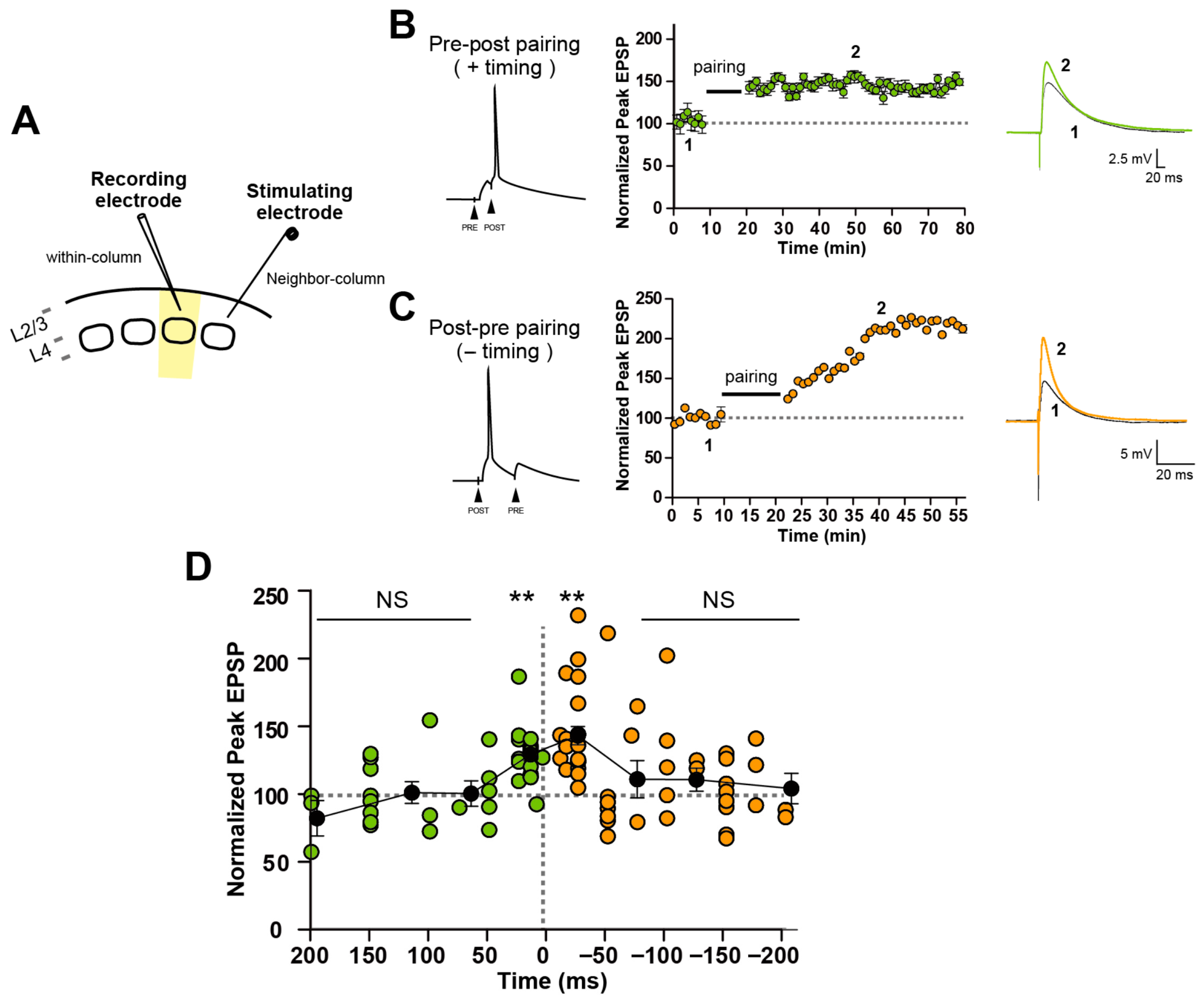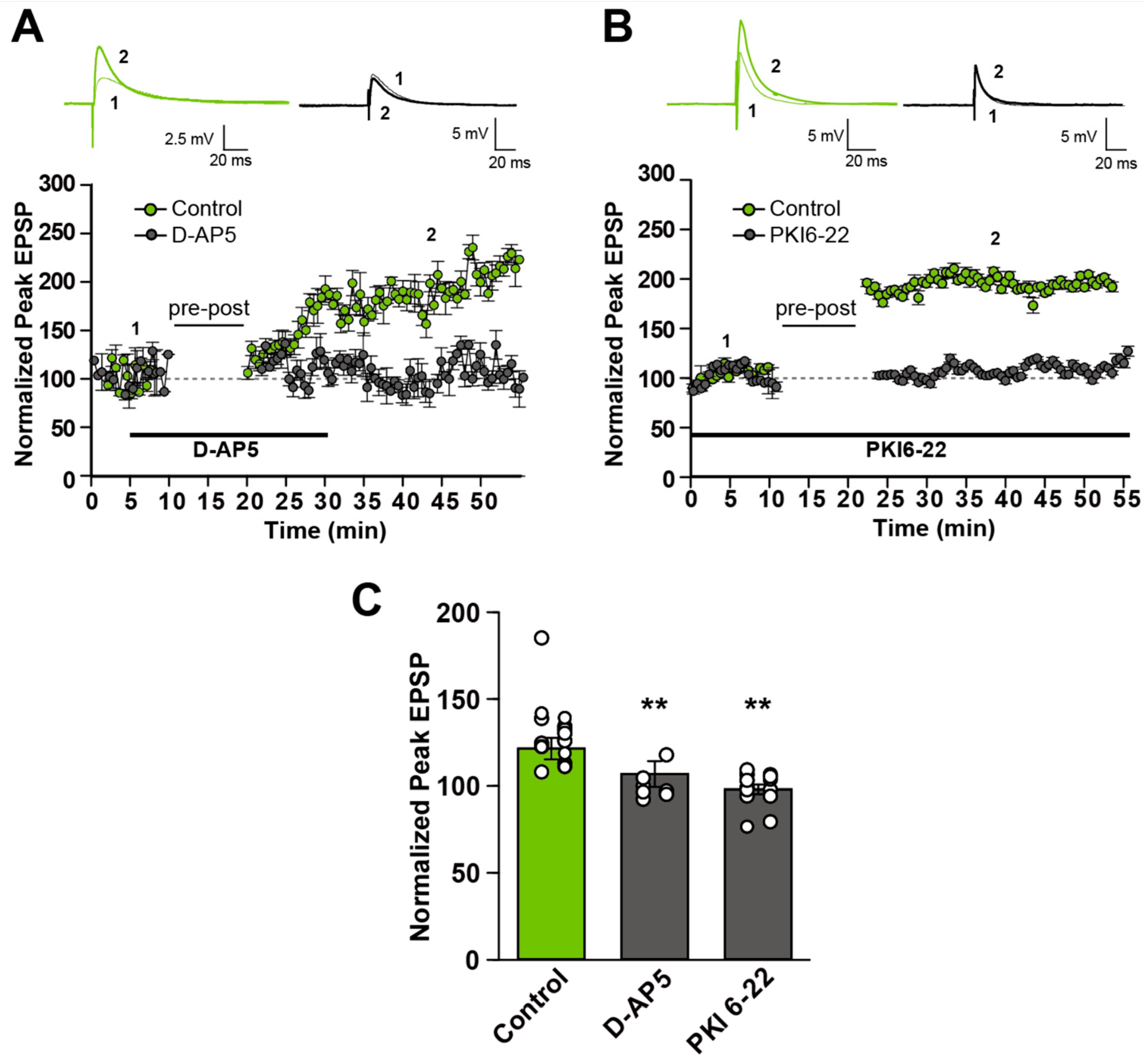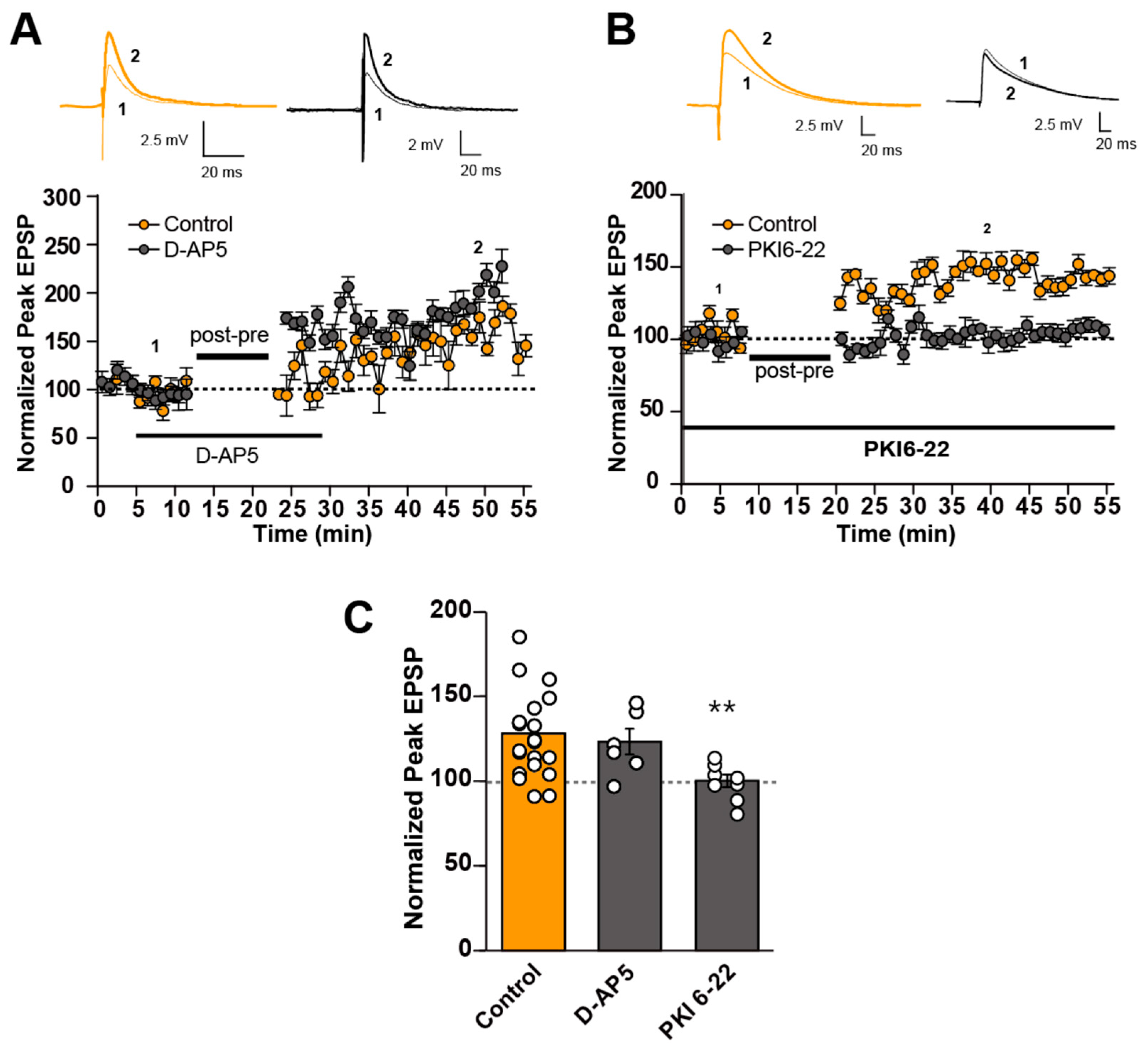Spike Timing-Dependent Plasticity at Layer 2/3 Horizontal Connections Between Neighboring Columns During Synapse Formation Before the Critical Period in the Developing Barrel Cortex
Abstract
1. Introduction
2. Materials and Methods
2.1. Slice Preparation for Electrophysiology
2.2. Electrophysiology
2.3. Induction Protocol for STDP
2.4. Drugs
2.5. Statistical Analysis
3. Results
3.1. L2/3 Horizontal Connections to Adjacent Column Exhibit All-LTP STDP After P9
3.2. LTP-STDP by Pre-Before-Post Timing Stimulation Requires NMDA Receptor and PKA
3.3. Distinct Induction Mechanism for LTP-STDP by Post-Before-Pre Timing Stimulation: It Requires PKA but Not NMDA-R
4. Discussion
4.1. All-LTP STDP at L2/3–L2/3 Horizontal Connection Between Neighboring Columns During Development
4.2. Involvement of PKA and NMDA-R
4.3. Involvement of NMDA-R
Author Contributions
Funding
Institutional Review Board Statement
Informed Consent Statement
Data Availability Statement
Conflicts of Interest
Abbreviations
| LTP | Long-term potentiation |
| LTD | Long-term depression |
| STDP | Spike timing-dependent plasticity |
| L4 | Layer 4 |
| L2/3 | Layer 2/3 |
References
- Feldman, D.E.; Brecht, M. Map plasticity in somatosensory cortex. Science 2005, 310, 810–815. [Google Scholar] [CrossRef] [PubMed]
- Kimura, F.; Itami, C. Hypothetical Model Concerning How Spike-Timing-Dependent Plasticity Contributes to Neural Circuit Formation and Initiation of the Critical Period in Barrel Cortex. J. Neurosci. 2019, 39, 3784–3791. [Google Scholar]
- Allen, C.B.; Celikel, T.; Feldman, D.E. Long-term depression induced by sensory deprivation during cortical map plasticity in vivo. Nat. Neurosci. 2003, 6, 291–299. [Google Scholar] [CrossRef]
- Itami, C.; Kimura, F. Developmental switch in spike timing-dependent plasticity at layers 4-2/3 in the rodent barrel cortex. J. Neurosci. 2012, 32, 15000–15011. [Google Scholar] [CrossRef]
- Glazewski, S.; Fox, K. Time course of experience-dependent synaptic potentiation and depression in barrel cortex of adolescent rats. J. Neurophysiol. 1996, 75, 1714–1729. [Google Scholar] [CrossRef]
- Kossut, M. Experience-dependent changes in function and anatomy of adult barrel cortex. Exp. Brain Res. 1998, 123, 110–116. [Google Scholar] [CrossRef] [PubMed]
- Wallace, H.; Fox, K. Local cortical interactions determine the form of cortical plasticity. J. Neurobiol. 1999, 41, 58–63. [Google Scholar] [CrossRef]
- Foeller, E.; Feldman, D.E. Synaptic basis for developmental plasticity in somatosensory cortex. Curr. Opin. Neurobiol. 2004, 14, 89–95. [Google Scholar] [CrossRef] [PubMed]
- Fox, K. Anatomical pathways and molecular mechanisms for plasticity in the barrel cortex. Neuroscience 2002, 111, 799–814. [Google Scholar] [CrossRef]
- Hickmott, P.; Merzenich, M.M. Local circuit properties underlying cortical reorganization. J. Neurophysiol. 2001, 88, 1288–1301. [Google Scholar] [CrossRef]
- Rioult-Pedotti, M.S.; Friedman, D.; Donoghue, J.P. Learning-induced LTP in neocortex. Science 2000, 290, 533–536. [Google Scholar] [CrossRef] [PubMed]
- Finnerty, G.T.; Roberts, L.S.; Connors, B.W. Sensory experience modifies the short-term dynamics of neocortical synapses. Nature 1999, 400, 367–371. [Google Scholar] [CrossRef] [PubMed]
- Hirsch, J.A.; Gilbert, C.D. Synaptic physiology of horizontal connections in the cat’s visual cortex. J. Neurosci. 1991, 11, 1800–1809. [Google Scholar] [CrossRef]
- Itami, C.; Huang, J.Y.; Yamasaki, M.; Watanabe, M.; Lu, H.C.; Kimura, F. Developmental Switch in Spike Timing-Dependent Plasticity and Cannabinoid-Dependent Reorganization of the Thalamocortical Projection in the Barrel Cortex. J. Neurosci. 2016, 36, 7039–7054. [Google Scholar] [CrossRef]
- Larsen, D.D.; Callaway, E.M. Development of layer-specific axonal arborizations in mouse primary somatosensory cortex. J. Comp. Neurol. 2006, 494, 398–414. [Google Scholar] [CrossRef] [PubMed]
- Itami, C.; Kimura, F.; Nakamura, S. Brain-derived neurotrophic factor regulates the maturation of layer 4 fast-spiking cells after the second postnatal week in the developing barrel cortex. J. Neurosci. 2007, 27, 2241–2252. [Google Scholar] [CrossRef]
- Kimura, F.; Itami, C.; Ikezoe, K.; Tamura, H.; Fujita, I.; Yanagawa, Y.; Obata, K.; Ohshima, M. Fast activation of feedforward inhibitory neurons from thalamic input and its relevance to the regulation of spike sequences in the barrel cortex. J. Physiol. 2010, 588, 2769–2787. [Google Scholar] [CrossRef]
- Itami, C.; Samejima, K.; Nakamura, S. Improved data processing for optical imaging of developing neuronal connectivity in the neonatal mouse barrel cortex. Brain Res. Protoc. 2001, 7, 103–114. [Google Scholar] [CrossRef]
- Agmon, A.; Connors, B.W. Thalamocortical responses of mouse somatosensory (barrel) cortex in vitro. Neuroscience 1991, 41, 365–379. [Google Scholar] [CrossRef]
- Gottlieb, J.P.; Keller, A. Intrinsic circuitry and physiological properties of pyramidal neurons in rat barrel cortex. Exp. Brain Res. 1997, 115, 47–60. [Google Scholar] [CrossRef]
- Kelly, P.T.; McGuinness, T.L.; Greengard, P. Evidence that the major postsynaptic density protein is a component of a Ca2+/calmodulin-dependent protein kinase. Proc. Natl. Acad. Sci. USA 1984, 81, 945–949. [Google Scholar] [CrossRef]
- Miller, S.G.; Kennedy, M.B. Distinct forebrain and cerebellar isozymes of type II Ca2+/calmodulin-dependent protein kinase associate differently with the postsynaptic density fraction. J. Biol. Chem. 1985, 260, 9039–9046. [Google Scholar] [CrossRef] [PubMed]
- Malinow, R.; Schulman, H.; Tsien, R.W. Inhibition of postsynaptic PKC or CaMKII blocks induction but not expression of LTP. Science 1989, 245, 862–866. [Google Scholar] [CrossRef] [PubMed]
- Silva, A.J.; Stevens, C.F.; Tonegawa, S.; Wang, Y. Deficient hippocampal long-term potentiation in alpha-calcium-calmodulin kinase II mutant mice. Science 1992, 257, 201–206. [Google Scholar] [CrossRef]
- Hayashi, Y.; Shi, S.H.; Esteban, J.A.; Piccini, A.; Poncer, J.C.; Malinow, R. Driving AMPA receptors into synapses by LTP and CaMKII: Requirement for GluR1 and PDZ domain interaction. Science 2000, 287, 2262–2267. [Google Scholar] [CrossRef]
- Hardingham, N.; Glazewski, S.; Pakhotin, P.; Mizuno, K.; Chapman, P.F.; Giese, K.P.; Fox, K. Neocortical long-term potentiation and experience-dependent synaptic plasticity require alpha-calcium/calmodulin-dependent protein kinase II autophosphorylation. J. Neurosci. 2003, 23, 4428–4436. [Google Scholar] [CrossRef]
- Esteban, J.A.; Shi, S.H.; Wilson, C.; Nuriya, M.; Huganir, R.L.; Malinow, R. PKA phosphorylation of AMPA receptor subunits controls synaptic trafficking underlying plasticity. Nat. Neurosci. 2003, 6, 136–143. [Google Scholar] [CrossRef] [PubMed]
- Zhu, J.J.; Esteban, J.A.; Hayashi, Y.; Malinow, R. Postnatal synaptic potentiation: Delivery of GluR4-containing AMPA receptors by spontaneous activity. Nat. Neurosci. 2000, 3, 1098–1106. [Google Scholar] [CrossRef]
- Sugiura, H.; Yamauchi, T. Developmental changes in the levels of Ca2+/calmodulin-dependent protein kinase II alpha and beta proteins in soluble and particulate fractions of the rat brain. Brain Res. 1992, 593, 97–104. [Google Scholar] [CrossRef]
- Chetkovich, D.M.; Sweatt, J.D. NMDA receptor activation increases cyclic AMP in area CA1 of the hippocampus via calcium/calmodulin stimulation of adenylyl cyclase. J. Neurochem. 1993, 61, 1933–1942. [Google Scholar] [CrossRef]
- Roberson, E.D.; Sweatt, J.D. Transient activation of cyclic AMP-dependent protein kinase during hippocampal long-term potentiation. J. Biol. Chem. 1996, 271, 30436–30441. [Google Scholar] [CrossRef] [PubMed]



Disclaimer/Publisher’s Note: The statements, opinions and data contained in all publications are solely those of the individual author(s) and contributor(s) and not of MDPI and/or the editor(s). MDPI and/or the editor(s) disclaim responsibility for any injury to people or property resulting from any ideas, methods, instructions or products referred to in the content. |
© 2025 by the authors. Licensee MDPI, Basel, Switzerland. This article is an open access article distributed under the terms and conditions of the Creative Commons Attribution (CC BY) license (https://creativecommons.org/licenses/by/4.0/).
Share and Cite
Itami, C.; Kimura, F. Spike Timing-Dependent Plasticity at Layer 2/3 Horizontal Connections Between Neighboring Columns During Synapse Formation Before the Critical Period in the Developing Barrel Cortex. Cells 2025, 14, 1459. https://doi.org/10.3390/cells14181459
Itami C, Kimura F. Spike Timing-Dependent Plasticity at Layer 2/3 Horizontal Connections Between Neighboring Columns During Synapse Formation Before the Critical Period in the Developing Barrel Cortex. Cells. 2025; 14(18):1459. https://doi.org/10.3390/cells14181459
Chicago/Turabian StyleItami, Chiaki, and Fumitaka Kimura. 2025. "Spike Timing-Dependent Plasticity at Layer 2/3 Horizontal Connections Between Neighboring Columns During Synapse Formation Before the Critical Period in the Developing Barrel Cortex" Cells 14, no. 18: 1459. https://doi.org/10.3390/cells14181459
APA StyleItami, C., & Kimura, F. (2025). Spike Timing-Dependent Plasticity at Layer 2/3 Horizontal Connections Between Neighboring Columns During Synapse Formation Before the Critical Period in the Developing Barrel Cortex. Cells, 14(18), 1459. https://doi.org/10.3390/cells14181459





